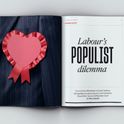If, as Chris Mullin argues, a new nationalist populism has taken charge of the Tory Party, just how far will it go? Ultimately, of course, that depends on how long it can dominate parliament. We’ve learned a lot about its chances this spring.
It was immediately obvious that the 2016 referendum could redraw the political map: England’s rust belt towns, traditionally solidly Labour, “disobeyed” their party and opted for Leave. The next year, after the Tories took a Brexit turn, they lost Remain redoubts such as Canterbury and Kensington in Theresa May’s misfiring election. Then, after two years of Brexit negotiations, many “Labour Leavers” decided they were more Leaver than Labour, and former industrial communities like Bolsover, Bassetlaw and Blyth Valley turned Tory for the first time.
Even putting aside the special case of Scotland and Labour’s structural losses there, we seemed to be two political countries. Comparing Boris Johnson’s 2019 victory with a baseline of 2015 (the last general election before Brexit messed with the dial), Steve Fisher of Oxford University calculates that the cumulative swing to the Tories across “Leaveland” in England and Wales was a touch under 5 per cent, offset by a swing of just under 4 per cent towards Labour in “Remainia.”
So how far was this realignment produced by the passing passions of years of Brexit wrangling? This remained an open question until Britain finally left the single market this year. But now the dramatic result of the Hartlepool by-election—an exceptionally rare government midterm gain in a former Labour heartland—suggests the referendum faultlines are deepening rather than fading. Fisher confirmed this pattern across local election results, crunching hundreds of wards and uncovering “an increasing correlation between the Conservative performance and the estimated ward-level Leave vote.” “The so-called ‘Brexit realignment,’” the professor’s analysis for Prospect concluded, “seems to have strengthened, not weakened, now Brexit is ‘done.’”
Of course, there is a corresponding progressive upside elsewhere in the country: prosperous places like Cambridgeshire and vibrant cities like Manchester moved left in May. But Remainia is by far the smaller country. Despite the close 52-48 per cent headline referendum vote, what matters for Westminster is the spread of votes across seats. Remain votes piled up in the cities, and the best estimate is that 409 constituencies went for Leave in 2016, against 241 where a majority wanted to stay in Europe. So this realignment is to the disadvantage of the left. Moreover, just as the Conservatives have consolidated on the right, by mopping up virtually all of the old Ukip votes, Fisher found this spring’s results witnessed increasing splintering among the social liberals, for example with a rise in Green support denting Labour.
Still, in principle this realignment doesn’t have to push policy right. If “left-behind” towns, not suburbs, are the new marginals, there could be rewards for a left-leaning economic agenda: witness the talk of “levelling up.” But the tides running against post-industrial towns are deep. If practical plans to restore better times for them falter, a retreat into the politics of nostalgia and rage becomes sorely tempting.
Look at what happened to the US Republicans after they cracked, first, the Democrats’ “solid south” (over segregation in the 1960s) and then economically exhausted places like West Virginia a generation later. They resorted to a narrow nationalist turn that culminated with Trump. It might not happen here. But if it did, there would be little in the British constitution or indeed in the Conservative Party leadership rules—where the final say goes to the ageing membership—to provide much in the way of a check or balance.













